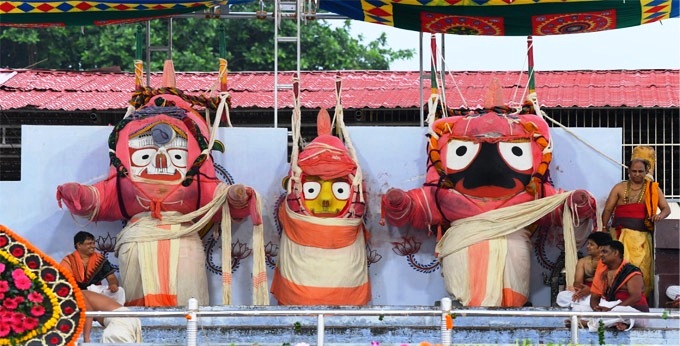Puri: The much-awaited and divine Snana Yatra of Lord Jagannath has begun in Odisha, Friday with imposition of 144 CrPC restrictions around Srimandir.
“For the first time in the history of Srimandir, a prohibitory order like the Section 144 of the CrPC has been imposed around Srimandir on the occasion of Snana Yatra,” said a researcher.
The Grand Road appeared completely empty as devotees were forced to witness the Snana Yatra from the comforts of their homes.
At 3.10 am the servitors took the holy trinity along with Lord Sudarshana to the ‘Snana Bedi’ (bathing altar) in ‘Dhadi Pahandi’ in order to perform the bathing rituals of the deities.
The servitors had performed ‘Mangaladarpana’ at around 1.25am after which the ‘pahandi’ started at 1.40 am and ended at 3.10 am when Lord Balabhadra, Devi Subhadra, Lord Jagannath & Lord Sudarsan reached the bathing altar.
‘Madanmohan Bije’ ritual was performed at 3.40 am followed by ‘Mangal Alati’ at 4.20am, ‘Mailam and Tadaplagi’ ritual at 4.35am, ‘Adharpochha’ at 4.50 am, ‘Abakash’ ritual at 5.30am and ‘Roshahoma’ ritual at 5.40am.
However due to the prevailing COVID-19 and Sec 144 restrictions this year, Gajapati Dibyasingha Deb couldn’t come to perform ‘Chherapahara’ ritual of the deities. For this, ‘Mudirasta’ who is also known as the representative of Gajapati Dibyasingha Deb, performed the ‘Chherapahara’ (sweeping ritual) on the Snana Bedi.
As per the Temple rule, a minor boy from Brhamin Servitor Samiti in Puri can perform the role of a Mudirasta.
After the bathing ceremony of the deities is observed on the Snana Bedi, the deities are dressed like Lord Ganesha who bears the head of an elephant (Hati). Lord Jagannath and Balabhadra appear like Ganesha or black and white elephants respectively.
Similarly, Snana Yatra of lord Baldevjeu in Tulasikhetra at Kendrapara district has also begun without much pomp and gaiety. A very limited number of servitors took Lord Baldevjeu, Lord Jagannath and Devi Subhadra to the Snana Bedi after performing ‘Mangaladarpana’ in the temple.
The lords will be dressed in ‘Hati Besha’ Friday afternoon. And ‘Bahuda Pahandi’ will be performed around 5.00 pm.
On the other hand, Snana Yatra in Sri Balram Temple in Dhenkanal district was also performed, Friday. The servitors have started the ‘Chandan Lagi Besa’ of the three deities.
The priests of ISKCON temple in Bhubaneswar also performed the bathing ritual of three deities.
About Snana Yatra:
The Snana Yatra is a bathing festival celebrated on the Purnima (full moon day) of the Hindu month of Jyeshtha.It is an important festival for the Sanatana or Hindu dharma. It is the birth day of lord Jagannath.
This is the first occasion in the year as per the Hindu calendar, when the deities Jagannath, Balabhadra, Subhadra, Sudarshan, and Madanmohan are brought out from the Jagannath Temple (Puri) and taken in a procession to the Snana Bedi. There they are ceremonially bathed and decorated for a public audience with the devotees.
It is a belief among devotees of Lord Jagannath that if they make a pilgrimage to see the deity on this day, they would be cleansed of all of their sins. Hundreds of thousands of devotees visit the temple on the occasion. The Skanda Purana mentions that King Indradyumna arranged this ceremony for the first time when the idols of the deities were first installed.
On the eve of the Snana Yatra the idols of the deities are brought out in a grand procession from the garbhagriha (sanctum sanctorum) to the Snana Bedi (bathing platform). Devotees come to view the deities.
But this year, the mega event has been organised without the presence of devotees due to the coronavirus scare.
On the day of the Snana Yatra, the deities are bathed with 108 pots, of ritually purified water drawn from the northern well of the temple to the accompaniment of religious incantations. In the evening, at the conclusion of the bathing ritual, Jagannath and Balabhadra are dressed up in elephant headgear representing the God Ganesh. This form of the God is called the ‘Gajavesha’.
After the Snana Yatra the Gods are traditionally believed to fall ill and are kept in a sick room to recuperate in privacy under the care of the Raj Vaidya.
During this period known as Anasara the Gods cannot be seen by devotees. At this time three pata chitra paintings are displayed for devotees to view instead It is said that with the Ayurvedic medication (‘pnachan’) administered by the Raj Vaidya the Gods recover in a fortnight and resume giving an audience to their devotees.
During the Anasara period devotees head to the Alarnatha Mandira in Bramhagiri in the belief that Jagannath manifests as Alarnatha during this period.
After the Anasara ritual the Nabajouban Darshan ritual of the deities would be performed June 20 while the annual Rath Yatra is scheduled to be organised June 23.
PNN
